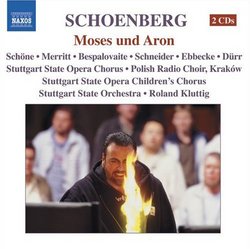| All Artists: Arnold Schoenberg, Roland Kluttig, Stuttgart State Orchestra, Stuttgart State Opera Orchestra, Chris Merritt, Wolfgang Schone, Bernhard Schneider, Helga Rós Indridadóttir, Irena Bespalovaite, Emma Curtis, Karl-Friedrich Dürr, Michael Ebbecke, Ulrich Frisch, Naomi Ishizu, Barbara Kosviner, Siegfried Laukner, Alois Riedel, Peter Schaufelberger, Stephan Storck, Sasa Vrabac Title: Schoenberg: Moses und Aron Members Wishing: 0 Total Copies: 0 Label: Naxos Original Release Date: 1/1/2006 Re-Release Date: 8/29/2006 Genre: Classical Styles: Opera & Classical Vocal, Historical Periods, Modern, 20th, & 21st Century Number of Discs: 2 SwapaCD Credits: 2 UPC: 730099615822 |
Search - Arnold Schoenberg, Roland Kluttig, Stuttgart State Orchestra :: Schoenberg: Moses und Aron
 | Arnold Schoenberg, Roland Kluttig, Stuttgart State Orchestra Schoenberg: Moses und Aron Genre: Classical
|
Larger Image |
CD Details |
CD ReviewsMoses und Aron on Naxos Robin Friedman | Washington, D.C. United States | 09/05/2006 (5 out of 5 stars) "Arnold Schoenberg (1874 -- 1951) was a revolutionary in music and a seeker in religion. As a revolutionary, Schoenberg became famous and, in some quarters, reviled for his development of atonal and twelve-tone music. As a seeker, Schoenberg was born Jewish but converted to Lutheranism in 1894. He returned to Judaism in 1933, after many years of reflection, with the rise to power of the Nazis. As Malcom MacDonald notes in his 1976 biography, Schoenberg "remained to the end of his day a searcher, both less and more than an orthodox Jew. His final literary work, the Modern Psalms, is among other things a critique of various aspects of Judaism." (MacDonald, "Schoenberg" at 55).
The revolutionary character of Schoenberg's music and his uneasy religiosity combine in his great opera, Moses and Aaron, composed between 1930 and 1932. The opera is a massive, monumental work which not only uses the twelve-tone scale throughout, but also constitutes a many-sided set of variations on a single row. Schoenberg wrote the liberetto for his opera, which gives the composer's highly personal version of the conflict between Moses, with his revelation of a totally incorporeal, infinite, and one God, and his brother Aaron, who argues that images are a necessary means for a finite and frail humanity to approach the divine. In this new 2CD set on Naxos, Roland Klutting conducts the Stuttgart State Orchestra and Stuttgart State Opera Chorus, and Children's Chorus, and the Polish Radio Choir in a recording of live performances in Stuttgart in December 2003. The recording captures the craggy, gnarly character of Schoenberg's music and story. Wolfgang Schone and Chris Morritt perform impressively as the two brothers, but the outstanding performances on this recording belong to the orchestra and to the chorus. The opera, as we have it, is in two acts. (Schoeberg wrote the libertto for a brief third act but never completed it.) The first act opens with God's revelation to Moses at the Burning Bush. It proceeds as Moses, slow and tounge-tied (he speaks haltingly rather than sings throughout the opera) tries to explain his revelation to Aaron and then, through Aaron to a skeptical Jewish people in Egypt. Only upon the performance of miracles do the people accept Moses and his God. The second Act moves to the wandering of the Jews in the desert and tells the story of the Golden Calf. As Moses is delayed for 40 days on the mountain, the people grow restless and prevail upon Aaron to make the Golden Calf. Moses returns from the mountain, destroys the Calf with a word, smashes the tablets of the Law, and rebukes Aaron. He falls to the ground believing he has failed in the mission to which God appointed him. Schoenberg's score opens erily with light winds and voices capturing the revelation of the Burning Bush. Moses and Aaron argue together and try to convince the people with Aaron signing a high, melodious tenor and Moses stammering. The choruses are stunning and fugal and capture the fickleness of the people and the difficulty of the religious quest. The highlight of Moses and Aaron is in the second act in a long scene of Dances around the Golden Calf. This is absolutely orgiastic music for orchestra and chorus, in which animals are led to the idol as sacrifices, the slaughterers dance, four naked virgins come forward to sacrifice themselves, and the scene deteriorates into a fury of rape, murder, and lust as Moses returns. Schoenberg's music captures this increasing fury and a tumultous score that reminds many listeners of Stravinsky's "Rite of Spring." At the conclusion of the opera, the remnants of the Israelites march off behind Aaron with Moses, seemingly, broken in spirit. Moses and Aaron is atonal throughout, and there are no demarcations between arias and recitives. It is composed in large blocks of scenes. With all of that, the music is not terribly difficult to follow, as Schoenberg crafts his score to suggest the unknowability of God and the furious power of human passion. The opera is a work of religious music, one of the greatest of the Twentieth Century. Listeners with an adventurous and open spirit who want to explore the seminal work of a still controversial composer should turn to this Naxos CD of Schoenberg's great opera. Robin Friedman" |

 Track Listings (6) - Disc #1
Track Listings (6) - Disc #1